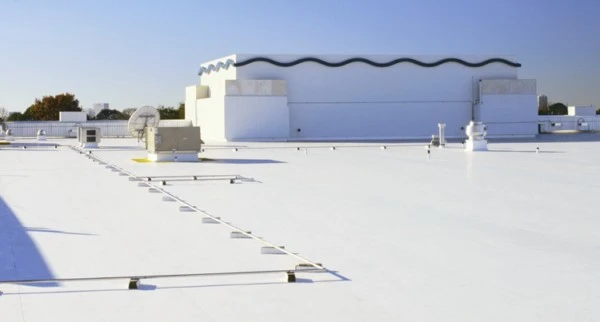
In the ever-evolving world of roofing, where innovation meets practicality, a new contender has emerged as the champion of flat and low-slope roofs: TPO roofing. Thermoplastic Polyolefin, or TPO for short, isn’t just another acronym in the construction industry; it’s a game-changer that’s redefining the way we think about protecting our buildings.
Gone are the days of leaky, energy-guzzling flat roofs. TPO has swooped in with its sleek, reflective surface and a host of advantages. From its exceptional energy efficiency and unparalleled durability to its wallet-friendly price tag and hassle-free installation, TPO is the superhero that flat roofs have been waiting for.
Whether you’re a homeowner looking to upgrade your roof or a commercial property owner seeking a reliable solution for your sprawling complex, TPO roofing promises a future where flat roofs are no longer a liability but an asset.
What is TPO Roofing?

So, what exactly is TPO roofing? At its core, TPO stands for Thermoplastic Polyolefin, which sounds more like a science experiment than a roofing material. But fear not, there’s no need to dust off your chemistry textbook. TPO is simply a single-ply membrane crafted from a clever blend of polypropylene and ethylene-propylene rubber. This dynamic duo creates a flexible, weather-resistant sheet that’s ready to take on the elements.
Now, not all TPO membranes are created equal. You’ll encounter two main types: reinforced and unreinforced. Reinforced TPO contains a layer of polyester scrim or fiberglass, which adds extra strength and puncture resistance. Unreinforced TPO, on the other hand, is lighter and more flexible, making it easier to install in tricky areas. Both types come in various thicknesses, typically ranging from 45 to 90 mils (a mil is one-thousandth of an inch). The thicker the membrane, the more durable and long-lasting it will be.
Think of TPO as the Swiss Army knife of roofing materials. Its versatility allows it to adapt to a variety of applications, from residential homes with low-slope roofs to sprawling commercial complexes. And unlike some roofing materials that require a complex installation process, TPO is relatively easy to install, often requiring fewer seams than other options. This translates to a faster, more cost-effective installation, which is music to any homeowner’s ears.
Contact us today (929) 370-1552 for a free consultation and let us show you how TPO roofing can transform your flat roof from a liability into an asset.
The Benefits of TPO Roofing

TPO isn’t just a trendy acronym; it’s a roofing solution that packs a powerful punch. Let’s dive into the impressive benefits that are making TPO the talk of the town:
Energy Efficiency
Imagine a roof that acts like a shield against the scorching sun, reflecting its heat away from your building. That’s precisely what TPO does. Its highly reflective surface can significantly reduce heat absorption, resulting in lower cooling costs and a smaller carbon footprint. In fact, many TPO roofs earn the coveted ENERGY STAR rating, a testament to their exceptional energy efficiency.
Durability: Built to Last
TPO isn’t afraid of a little roughhousing. It’s designed to withstand punctures, tears, UV radiation, and even extreme weather conditions. Whether it’s a hailstorm, a blizzard, or a scorching summer day, TPO stands strong, protecting your building from the elements and ensuring a long-lasting roof that won’t quit.
Cost-Effectiveness
Who said quality has to come with a hefty price tag? TPO roofing offers an excellent balance of affordability and performance. Compared to other popular roofing materials like PVC and EPDM, TPO often comes out on top in terms of cost-effectiveness. It’s a smart investment that can save you money both during installation and over the lifespan of your roof.
Versatility
TPO isn’t a one-trick pony. Its versatility allows it to be used on a wide range of flat and low-slope structures, from cozy residential homes to massive industrial facilities. Whether you’re building a new structure or retrofitting an existing one, TPO can adapt to your needs and provide a reliable, long-lasting roofing solution.
Ease of Installation
Time is money, and TPO roofing understands that. Its installation process is relatively straightforward, often requiring fewer seams than other materials. This means less time spent on installation, resulting in lower labor costs and minimal disruption to your daily operations.
Environmental Friendliness
TPO roofing is more than just a practical choice; it’s also a responsible one. Many TPO membranes are recyclable, and their energy efficiency can contribute to LEED certification, a globally recognized symbol of sustainable building practices. With TPO, you can feel good about choosing a roofing material that’s kind to both your wallet and the environment.
TPO Roofing Installation Process

While TPO roofing boasts a DIY-friendly reputation, entrusting the installation to seasoned professionals is the key to unlocking its full potential. Think of it as commissioning a skilled artist to create a masterpiece on your rooftop. Here’s a glimpse into the meticulous process that transforms a roll of TPO into a weatherproof shield:
- Surface Preparation: The canvas must be primed before the artistry begins. The existing roof is thoroughly cleaned, repaired, or removed if necessary. Any imperfections or debris could compromise the integrity of the new TPO membrane.
- Insulation: Insulation isn’t just about keeping your home cozy; it’s also a crucial component of a TPO roofing system. A layer of insulation, often rigid foam board, is meticulously installed to enhance energy efficiency and prevent heat loss or gain.
- Membrane Installation: Now comes the main act – unrolling the TPO membrane. It’s carefully laid out across the roof, ensuring proper overlap and alignment. Depending on the chosen method, the membrane is either mechanically fastened or adhered using specialized adhesives.
- Seaming: The seams where the TPO sheets meet are the Achilles’ heel of any roofing system. That’s why TPO seams are meticulously sealed using heat welding or chemical adhesives. This creates a watertight bond that prevents leaks and ensures the longevity of your roof.
- Flashing: Flashing is the unsung hero of roofing. It’s installed around roof penetrations like vents, pipes, and skylights to prevent water infiltration. With TPO, flashing is often made from the same material, ensuring a seamless, cohesive look.
- Final Touches: Once the TPO membrane and flashing are in place, the final touches are added. This may include installing drip edges, edge metal, and other accessories that enhance the functionality and aesthetics of your new roof.
By leaving the installation to the pros, you can rest assured that your TPO roof will be installed with precision and expertise, maximizing its lifespan and ensuring optimal performance.
Contact us today (929) 370-1552 for a free consultation and let us show you how TPO roofing can transform your flat roof from a liability into an asset.
Maintenance and Lifespan of TPO Roofs

One of the most enticing aspects of TPO roofing is its low-maintenance nature. Unlike some roofing materials that demand constant attention, TPO is a bit of a set-it-and-forget-it option. Of course, that doesn’t mean you can completely neglect your roof. A little TLC goes a long way in ensuring its longevity and optimal performance.
Here’s a quick rundown of what you can expect in terms of TPO roof maintenance:
- Occasional Cleaning: TPO roofs are relatively resistant to dirt and debris buildup, but it’s a good idea to give them a good cleaning once or twice a year. This can be as simple as rinsing them with a hose or using a mild detergent and a soft-bristle brush for stubborn stains.
- Regular Inspections: It’s wise to schedule a professional roof inspection at least once a year, especially after severe weather events. A trained eye can spot potential issues like punctures, seam separations, or flashing damage before they escalate into major problems.
With minimal upkeep, you can expect your TPO roof to last anywhere from 20 to 30 years, or even longer in some cases. This impressive lifespan is due to TPO’s inherent durability and resistance to the elements. However, several factors can influence the lifespan of your roof, including:
- Climate: Extreme heat, cold, or frequent storms can accelerate wear and tear on any roofing material, including TPO.
- Installation Quality: A poorly installed TPO roof is more susceptible to leaks, punctures, and other issues that can shorten its lifespan.
- Maintenance: Neglecting regular cleaning and inspections can lead to problems that go unnoticed and untreated, potentially compromising the integrity of your roof.
By investing in a quality TPO roof and adhering to a simple maintenance routine, you can enjoy decades of worry-free protection for your home or business. It’s a wise investment that pays dividends in the long run.
Factors to Consider Before Choosing TPO Roofing
While TPO roofing offers a tempting array of benefits, it’s not a one-size-fits-all solution. Before diving headfirst into the world of TPO, it’s crucial to consider a few key factors that can influence your decision:
Climate
TPO thrives in a variety of climates, but it truly shines in hot and sunny regions. Its reflective surface excels at repelling the sun’s rays, keeping your building cool and comfortable even during scorching summers. However, if you live in an area prone to extreme cold or frequent hailstorms, it’s wise to consult with a roofing professional to determine if TPO is the best choice for your specific climate.
Building Type
TPO is primarily designed for flat and low-slope roofs, making it an ideal choice for both residential and commercial buildings. However, if your roof has a steep slope, other roofing materials might be better suited to your needs. It’s always best to discuss your specific building type with a roofing expert to ensure you’re choosing the right material for the job.
Budget
While TPO is generally more affordable than PVC roofing, it might be slightly more expensive than EPDM. It’s essential to strike a balance between cost and quality when choosing a roofing material. Consider your budget carefully and weigh the long-term benefits of TPO, such as energy savings and durability, against the initial investment.
Aesthetics
While TPO isn’t known for its wide range of colors and styles, it’s not entirely devoid of aesthetic appeal. White is the most common color, as it offers the highest reflectivity and energy efficiency. However, some manufacturers offer TPO in other colors like tan, gray, and even green. If aesthetics are a top priority, be sure to explore your options and choose a TPO membrane that complements the overall look of your building.
TPO vs. Other Roofing Materials
When it comes to flat and low-slope roofing, TPO isn’t the only game in town. Let’s size up the competition and see how TPO stacks up against other popular options:
TPO vs. EPDM (Ethylene Propylene Diene Monomer):
- Similarities: Both are single-ply membranes suitable for flat roofs.
- Differences: TPO is generally more energy-efficient due to its reflective surface, while EPDM is known for its exceptional resistance to hail and punctures. TPO installation typically involves heat welding or adhesive bonding, while EPDM seams are usually sealed with tape or adhesives.
TPO vs. PVC (Polyvinyl Chloride):
- Similarities: Both are single-ply membranes with good durability and weather resistance.
- Differences: PVC is often considered the most durable of the single-ply options, but it can be more expensive than TPO. TPO also has a slight edge in terms of energy efficiency due to its higher reflectivity.
TPO vs. Modified Bitumen:
- Similarities: Both are suitable for flat roofs and offer good durability.
- Differences: Modified bitumen is a multi-ply system that typically involves torching or hot mopping during installation, making it a more labor-intensive process. TPO, on the other hand, is easier and faster to install. TPO is also generally more energy-efficient and reflective.
The Verdict: TPO’s Winning Streak
While each roofing material has its own strengths and weaknesses, TPO consistently emerges as a top contender due to its impressive combination of energy efficiency, durability, cost-effectiveness, and ease of installation. It’s a versatile solution that can meet the needs of both residential and commercial property owners, offering a reliable, long-lasting roof that can withstand the test of time.
Ultimately, the best roofing material for your specific project will depend on various factors, including your budget, climate, building type, and aesthetic preferences. It’s always wise to consult with a roofing professional to assess your needs and determine the best course of action.
TPO roofing isn’t just a passing trend; it’s a revolution in the world of flat and low-slope roofs. With its unmatched energy efficiency, unwavering durability, cost-effectiveness, and ease of installation, TPO has earned its place as the go-to choice for homeowners and businesses alike.

By choosing TPO, you’re not just investing in a roof; you’re investing in a future where your building is protected from the elements, your energy bills are lower, and your environmental footprint is smaller. It’s a smart, sustainable choice that offers peace of mind and long-term value.
If you’re ready to experience the TPO difference, look no further than Alter Phase Roofing. Our team of experienced professionals is committed to providing top-notch TPO roofing solutions that are tailored to your specific needs and budget.
Contact us today (929) 370-1552 for a free consultation and let us show you how TPO roofing can transform your flat roof from a liability into an asset.




